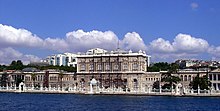seraglio
As Serail ( Turkish Saray from the Persian Saray /سرای) denotes the palace , residence and seat of government of an Ottoman central or regional ruler.
In Levantine Arabic , the Persian loan word appears asسراي or سرايا, DMG Sarāy, Sarāyā . It describes buildings for representation, residential purposes and administration from Ottoman times, because private rooms, including those for harem ladies , such as administrative rooms , were often under one roof.
In the European understanding, seraglio is primarily equated with the palace of an Ottoman sultan . Especially in the 18th century it was the epitome of the exotic ideas of Europeans of the (court) culture of the Ottoman Empire , as exemplified in Mozart's opera The Abduction from the Seraglio .
The large seraglio in Istanbul are considered masterpieces of Ottoman architecture, but Morocco also has several sultan's or royal palaces, some of whose architecture dates back to the Almohad , Merinid or Alawid times.
Important seraglio
- Beylerbeyi Palace in Istanbul
- Dolmabahce Palace in Istanbul
- İshak Paşa Palace in Doğubeyazıt
- Topkapı Sarayı (Cannon Gate Seraglio) in Istanbul
- Yıldız Palace in Istanbul
See also
- Saray , Sarai
- The abduction from the Seraglio
- Seraglio , engl. for Serail, an American comedy short film
Individual evidence
- ↑ "Museum of Heroism" , on: The Secrets of the Unearthly and Underground City of Akko , accessed on February 24, 2019.
- ↑ There are various examples of this in the former Ottoman Empire, for example the government building in Beirut is called the Grand Sérail (السراي الكبير'Great Seraglio'), similar to al-Sarāyā al-Hamrā (السرايا الحمراء'Red Seraglio') in Tripoli, Ak Saray (White Seraglio) in Ankara, Grand Sérail in Aleppo or the Old Seraglio in Acre.
